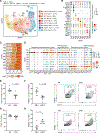Age-Associated Modulation of TREM1/2-Expressing Macrophages Promotes Melanoma Progression and Metastasis
- PMID: 40126543
- PMCID: PMC12352130
- DOI: 10.1158/0008-5472.CAN-24-4317
Age-Associated Modulation of TREM1/2-Expressing Macrophages Promotes Melanoma Progression and Metastasis
Abstract
Aging is a known risk factor for melanoma, yet mechanisms underlying melanoma progression and metastasis in older populations remain largely unexplored. Aging might alter phenotypes of cells in the melanoma microenvironment, selecting for populations that support metastatic progression. In this study, we have demonstrated that age engenders the development of an immunosuppressive tumor microenvironment, which is linked to phenotypes associated with melanoma metastasis. Among cellular populations enriched by aging were macrophages with a tolerogenic phenotype expressing TREM2 and dysfunctional CD8+ T cells with an exhausted phenotype, whereas macrophages with a profibrotic phenotype expressing TREM1 were depleted. Notably, TREM1 inhibition decreased melanoma growth in young but not in old mice, whereas TREM2 inhibition prevented lung metastasis in aged mice. These data identify age-related targets associated with melanoma metastasis and may guide age-dependent immunotherapeutic strategies.
Significance: TREM2 is elevated in melanoma-associated macrophages of aged mice and humans and can be inhibited to block melanoma metastasis, highlighting the role of the microenvironment in promoting aging-related metastasis.
©2025 American Association for Cancer Research.
Conflict of interest statement
Authors’ Disclosures
P.D. Adams reports grants from Sanford Burnham Prebys Medical Discovery Institute during the conduct of the study. K. Vuori and Z.A. Ronai report grants from NIH/NCI during the conduct of the study. Z.A. Ronai reports nonfinancial support from Pangea Biomed outside the submitted work. No disclosures were reported by the other authors.
Figures






Update of
-
Age-associated modulation of TREM1/2- expressing macrophages promotes melanoma progression and metastasis.bioRxiv [Preprint]. 2024 Nov 21:2024.11.20.624563. doi: 10.1101/2024.11.20.624563. bioRxiv. 2024. Update in: Cancer Res. 2025 Jun 16;85(12):2218-2233. doi: 10.1158/0008-5472.CAN-24-4317. PMID: 39605514 Free PMC article. Updated. Preprint.
References
-
- Tsai S, Balch C, Lange J. Epidemiology and treatment of melanoma in elderly patients. Nat Rev Clin Oncol 2010;7:148–52. - PubMed
-
- Siegel RL, Miller KD, Jemal A. Cancer statistics, 2018. CA Cancer J Clin 2018;68:7–30. - PubMed
-
- Hegde UP, Grant-Kels JM. Metastatic melanoma in the older patient: special considerations. Clin Dermatol 2013;31:311–6. - PubMed
MeSH terms
Substances
Grants and funding
LinkOut - more resources
Full Text Sources
Medical
Research Materials

